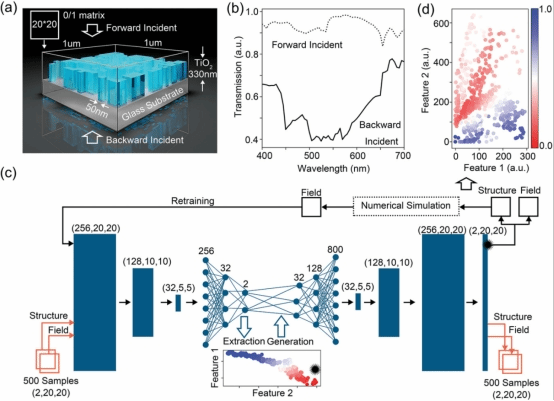Our team aim to use artificial intelligence in photonic design tasks. In sharp contrast with the conventional physics- or rule-based approaches, data-driven artificial intelligence algorithms provide an alternative view for scientific investigation and have played an important role in multiple research fields, such as resonant mode analysis, spectra calculation, and retrieval designing. By interfacing photonics with artificial intelligence, we can also inspire more applications of nanophotonic design and deliver new platforms for nanophotonic development.
A self-consistent framework of BoNet [Bayesian optimization (BO) and convolutional neural network (CNN)] can be used to design nanostructures for target optical properties in both near field and far field, which correspond to electric-field distributions and reflection spectra. Recent advances of CNNs exhibit significant advantages of describing geometric patterns and extracting complex implicit features from pictures. BO, as a derivative-free optimization algorithm, is independent of the continuity or derivability of the objective function. By investigating designs of nanostructures as pictures, CNN is directly used to build the mapping relationship between the geometric characters of nanostructure patterns and target properties without solving complex Maxwell’s functions, which can significantly increase computation efficiency and achieve considerable accuracy for both spectra and electric-field calculation compared
with numerical simulations. With performing BO to recommend a set of optimized inputs based on the current state of CNN model, these optimized inputs are used to reinforce the model. This process is iterated several times until the model converges to an allowable error. Then, the converged model is used to recommend optimized nanostructures. It is demonstrated that BoNet is able to
implement this efficient and practical platform for optical properties calculation and manipulation with optimized chirality in the reflection spectra.

BoNet workflow
Structural design is an important driving force for technological development in nanophotonics. To achieve better performance of nanophotonic devices, the freedom of structural design space needs to be expanded. Unsupervised learning algorithm in deep learning provides a great platform to expand design freedom of structures and avoid the “curse of dimensionality” effectively. It performs well on extracting important features from high-dimensional data and excavating potential rules. In this work, an unsupervised convolutional neural network is built to inversely design nanostructures with unidirectional transmission. Near-field information with high dimensions is recognized and extracted into a 2D feature space which maintains high physical continuity and maps to far-field transmittance effectively.

The exhibition of unsupervised learning framework for designing nanostructures with unidirectional transmission.
Representative works:
[1] Physical Review Letters 123: 213902, (2019).
[2] Adv. Optical Mater., 2200127, (2022).